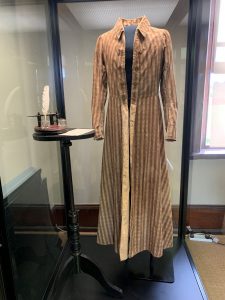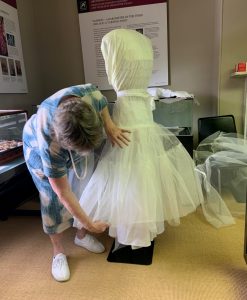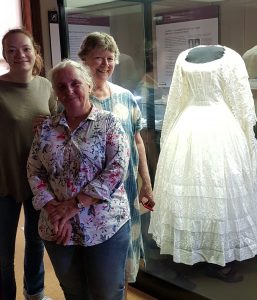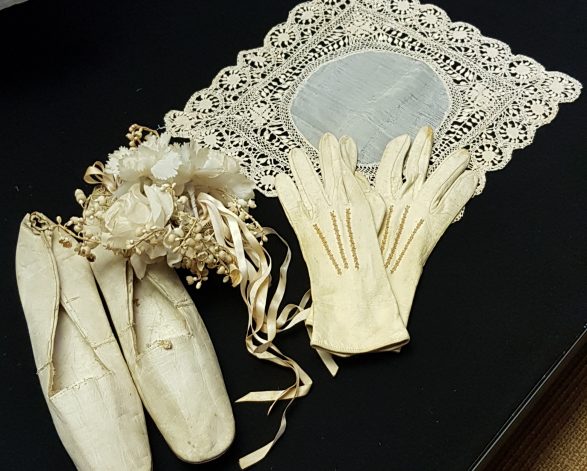Ever wondered how an exhibit is put together? Josephine Butcher, a National Trust volunteer, shares her experience of being involved in the careful preparation of a special 19th century display at Grossman & Brough House.
Two beautiful and rare garments from the Grossmann House collection are now on display in the Textile Room — a man’s banyan house coat, c1840, and a wedding dress, c1858, worn by Emma Maria Stack in Calcutta — belie the creative work behind the scenes that ensure the mannequins portray the details about the garments’ style, shape and history and bring to life the physiques of the people who would have worn them over 180 years ago.
I was fortunate indeed to witness, and in some small way assist, the work of Lindie Ward, who travelled from Sydney with Rebecca Pinchin, the National Trust (NSW) collection manager, and Yulia Belan, a collection volunteer, to dress and display the garments. Lindie, formerly the textile curator at the Powerhouse Museum, a superb professional artist, now retired. She created the polyethylene wire mesh flexible mannequins used in the Textile Room. Clothing is usually adjusted to match the mannequin’s lines, but here it was the reverse with the mannequins manipulated to fit the smaller 19th century garments.
 Treasures uncovered
Treasures uncovered
Once the garments were taken from the storage boxes and unwrapped from the acid-free tissue paper, various measurements were taken of the garments, the height of the stand was adjusted and the mannequin was attached to the rod with cable ties. The wire mesh frames were first covered with protective layers of acid-free tissue paper and soft polyester wadding, then cotton material was stitched over the shoulders, then came jersey material fashioned to drape the mannequins, which had been skilfully made by Ruth Edwards, sister of the Friends of Grossmann House collection coordinator, Lynn Morris. All these layers are required, not only to protect the garments from the wire mesh frames, but also to soften the look. The draped material is cinched at the waist with cotton tape for shaping.
The magic begins
These precious garments were reverentially carried from the collection storage room to the Textile Room for dressing. Lindie travels with a sewing box of assorted items including tools and cottons for stitching and adjustments to the undergarments. Pins are not allowed near the rare garments.
The male mannequin was dressed in a black jersey undergarment, hand-stitch-hemmed to the required length, and only then was the banyan coat placed on the mannequin. Lindie explained that the banyan, or ‘ten shilling’ dressing gown in this case, was styled after garments worn by Indian revenue officers who conducted business under banyan trees. The banyan coat is made of sturdy Indian cotton gingham and is very rare, as the common ones are not, as a rule, kept and collected – more often it is the rich brocades and satins that are preserved.
‘Socks’ of polyester wadding were inserted into the arms of the coat and more wadding used to fill the chest area. Lindie made adjustments by either squeezing or expanding the wire frame to the shape of the garment and a cotton ‘hook and eye’ sewn to fasten the front sides together, so that eventually it fell elegantly on the mannequin and the garment was once more given a life. Next, we found items from the collection to complement the display. These included a small elegant table, an inkstand with a feather pen (even the colour of the feather in the pen had to be decided upon!), and a 19th century original invoice used in Grossmann House. The gentleman’s display was complete!
 The perfect fit
The perfect fit
Attention then turned to Emma’s wedding dress — a beautiful and exquisite gown and a contrast to the more homely banyan coat. Excitement buzzed around the room. Lynn brought in a cotton under-petticoat and several gathered stiff tulle petticoats — these creating volume to give shape to the gown — which were tied in place onto the mannequin. Lindie, aided by Rebecca, carefully draped the gown over the mannequin.
Originating in India, the white gown is of fine hand-sewn muslin, decorated extensively with skilled white embroidery. It has a gathered bodice on a classic medium scooped neckline.
Lindie noted that the bodice had been altered as it originally would have extended to a point at the front of the waistline. The waist is also gathered to fall into a full skirt highlighting the embroidery work. Hooks and eyes are used to fasten down the bodice back. The dress has short sleeves of plain muslin.
Lindie’s professional eye was not quite satisfied as she viewed the model. She spied some black material and, to my amazement (watch and learn!), she skilfully used a lacquered chopstick from her sewing kit to tuck it into the gown and over the white under-fabric round the neckline. The resulting black décolletage against the white purity of the wedding dress’s neckline was dramatic and oh so stylish.
Further adjustments were required in the skirt as an extra piece of tulle was sewn onto the petticoat waist to balance the fullness. My comment as to the model’s lack of a bustline was soon remedied by Lindie with a little careful moulding of wadding giving further accents to the very slim waistline. A matching shawl of the same fabric and embroidery was gracefully draped over the shoulders to cascade down the back and sides to further complement and enhance the spectacular garment.
 The finishing touches
The finishing touches
To accompany this display Lynn drew on her extensive knowledge of the Grossmann collection to suggest many accessories for Lindie’s professional appraisal. After considerable discussion the final selection consisted of wedding accessories from many eras, the white kid shoes (c1830-40), a floral head garland of wax and silk flowers (c1890), kid gloves (c1910) and an exquisite silk handkerchief with Maltese bobbin lace border (c1880).
I was truly humbled and overjoyed to witness the professional artistry, craft and passion Lindie employed in dressing these two garments. After many, many hours’ work the human being inside the garments once more came to life. May I recommend readers come and view these wonderful rare garments and pause awhile to contemplate the workmanship involved in their presentation.
Start planning your trip to Grossman & Brough House in Maitland to see this very special exhibit which is on display until the end of the year. Check our website for opening times and tickets.

 Twitter
Twitter Facebook
Facebook Linkedin
Linkedin Email
Email
The exhibition sounds fascinating and fastidiously put together. I was a pupil at Maitland Girl’s High School and for 2 years had lessons in Grossman House. My family has donated a piece of porcelain to the museum. I visited the museum a few years ago and was impressed with the restoration of the old buildings.
I note on the table with the inkstand, behind the Banyan Coat Mannequin, you have displayed a quill pen. I have been a professional calligrapher for 30 years. Quill pens did not have feathers attached as you have presented the quill. That is a “Hollywood” fancy. The feathers were stripped back to the shaft because trying to write with the feathers attached was difficult and inefficient.
Sorry to be so pedantic, but in the interests of authenticity, the feathers should be stripped off the shaft with just a few left on one side. The ones left should be cut at an angle close to the shaft. There are plenty of photos on the internet. If you post me some feathers, I would be happy to do it for you. I am in Sydney.